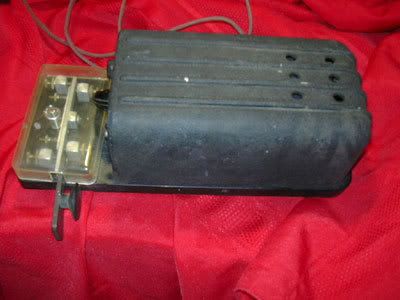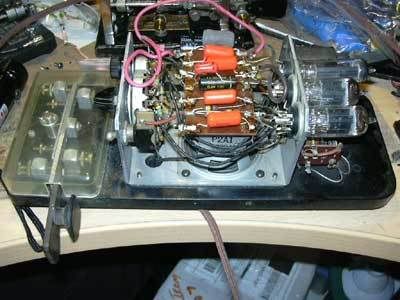After lunch today I checked the mail and found my order from Antique Electronic Supply had arrived. Wow, that was quick! i had just ordered the parts a couple of days ago.

The intended victim is the first commercially available electronic CW key, the Mon-Key. It was a product of the Electric Eye Equipment Co. of Danville, Ill. My example is undated, but in excellent physical condition. I picked it up on eBay last year. Of course, it was sold “as-is,” which is eBay-speak for “it's dead, Jim.”
And it was.
Plugged it in, hit the switch. Nothing. Nada. Zilch.
I had seen these sell for some substantial dough on eBay, probably because of its place in CW history. From what I've read from those who used one, it's not exactly as advanced as today's electronic keyers. I decided to buy one last year on a whim .. which was the same excuse I used to score my Icom 706, 746, Hammarlund HQ-140 and a dozen semi-automatic keys. Gonna have to watch those whims!
I found the manual and schematic for the Mon-Key, and its a pretty basic device. It has 3 tubes, one of which is a rectifier. The caps in the keyer were the old “black beauties,” and the chance that any of them were salvageable after more than 50 years was nil. New caps weren't that expensive, anyway. I removed the old ones one at a time and installed the new caps.
For the heck of it, I tried firing it up. Still nothing. After unplugging the unit, I dug out the VOM and began making continuity checks. The resistive line cord is good, and the on/off switch is passing voltage.

The filaments aren't lighting on the tubes, and since they're in series with the line cord, I'm thinking that one of the tube filaments is open. I haven't checked the entire filament circuit yet, but probably will later. I think I'm going to pick up new or NOS tubes for the key, just to eliminate them as a problem.
Other than caps, the tubes and a resistor network used for the speed control, there's really not a lot left to go wrong with the key.
Inside it looks untouched. Or did until I got in there. The photo I have posted shows several new caps changed out.
I'm looking foward to getting the Mon-Key operating. With the big honkin' relay this thing carries, I'm betting its a noisy outfit when you're using it.
MON-KEY HISTORY. The Mon-Key hit the market in 1948. While it was the first commercial key offered to hams, it was not the first keyer. Circuits for fully automatic electronic keying had graced the pages of QST beginning in the late 1930s. There were lots of refinements and different approaches taken to creating the “perfect” keyer — which wasn't easy to do with vacuum tubes.
The base of the Mon-Key is bakelite. The cover is aluminum. Looking at the Mon-Key, one might think its a heavy brute of a keyer. Not at all — it's not that heavy a key to heft.
The key was manufactured through the mid-1950s, and sold for about $29.95.
It will be interesting to compare it to the Hallicrafters HA-1 electronic keyer that went on the market in 1960. I have one of those and it lacks some of the features you expect in a keyer today, i.e., self-completing characters. It's rather noisy too in operation.
Well, I've buttoned the Mon-Key up and I will await time next week to tear into it again. I've got the rectifier tube already purchased.
73 es cul … de KY4Z dit dit …
